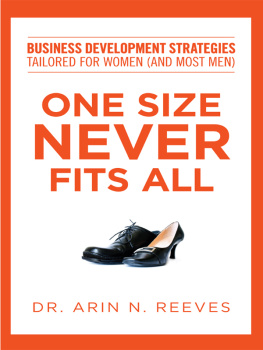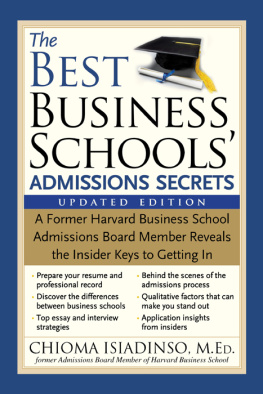The MBA Slingshot for Women
Using Business School to Catapult Your Career
Nicole M. Lindsay

Copyright 2014 Nicole M. Lindsay
All rights reserved. No part of this publication may be reproduced, stored in a retrieval system, or transmitted, in any form or by any means, electronic, mechanical, photocopying, recording, or otherwise, except for the inclusion of brief quotations in a review, without prior permission in writing from the publisher.
Library of Congress Cataloging-in-Publication Data
Lindsay, Nicole Marie, 1975
The MBA slingshot for women : using business school to catapult your career / Nicole M. Lindsay.
pages cm
ISBN 978-1-4408-3152-2 (hardback) ISBN 978-1-4408-3153-9 (ebook) 1. Master of business administration degree. 2. Women in higher education. 3. Career development. I. Title.
HF1111.L56 2014
650.071'1dc23 2013048510
ISBN: 978-1-4408-3152-2
EISBN: 978-1-4408-3153-9
18 17 16 15 14 1 2 3 4 5
This book is also available on the World Wide Web as an eBook.
Visit www.abc-clio.com for details.
Praeger
An Imprint of ABC-CLIO, LLC
ABC-CLIO, LLC
130 Cremona Drive, P.O. Box 1911
Santa Barbara, California 93116-1911
This book is printed on acid-free paper 
Manufactured in the United States of America
The MBA Slingshot for Women
The MBA Slingshot for Women
Using Business School to Catapult Your Career
Nicole M. Lindsay
PRAEGER
AN IMPRINT OF ABC-CLIO, LLC
Santa Barbara, California Denver, Colorado Oxford, England
To my parents, Thom and Frances McKinney, who sowed the strong seeds within me
Our deepest fear is not that we are inadequate. Our deepest fear is that we are powerful beyond measure. It is our light, not our darkness, that most frightens us. We ask ourselves, who am I to be brilliant, gorgeous, talented, fabulous? Actually, who are you not to be? You are a child of God. Your playing small doesnt serve the world. Theres nothing enlightened about shrinking so that other people wont feel insecure around you. We are all meant to shine, as children do. We were born to make manifest the glory of God that is within us. Its not just in some of us; its in everyone. And as we let our own light shine, we unconsciously give other people permission to do the same. As were liberated from our own fear, our presence automatically liberates others.
Marianne Williamson, A Return to Love
Contents
Acknowledgments
The idea for The MBA Slingshot for Women began to emerge on an all-ladies trip to Jamaica in February 2011. Within four months, I had quit my job and was working on the book full-time. In the two years that would follow, consulting projects and entrepreneurial endeavors pulled me away, but I kept coming back to it. This journey has been awesome and yet at times challenging. Through it all, I have had the love and support of my husband, Josiah, and I am profoundly grateful for that. Thank you, baby.
I am also grateful for the encouragement and support that I have received from so many of my family members, friends, and colleagues. You all deserve to be mentioned by name, but the list would be too long and I would invariably omit someone important. You know who you are. Now know how much I appreciate you!
A special thanks to Melanie Hart, my bunkmate on that trip to Jamaica, who always pushes me to dream bigger. Thank you also to those who helped me brainstorm, outline, and review chapters and helped me figure out this book-writing businessmost notably, Jullien Gordon, Aimee Slater, Chika Anoliefo, Daria Burke, Martin Davidson, Amanda Roberts, Gretchen Anderson, Nadira Hira, Natalie Sullivan, Bonnie Hearn Hill, and Kellie Sauls. A special shout-out goes to my twin brother, Anthony, and big brother, Thomasjust cause!
While this book captures much of what I have learned and personally experienced, it was shaped by so many tremendous master of business administration (MBA) women and others I have met along my journey. When I started the interviews for the book, I was headed in a slightly different direction than the one that ultimately got me to The MBA Slingshot for Women, but the insights gained were no less valuable. A very special thank you to all who participated in the interview process for sharing your knowledge, stories, and experiences with me: Carolyn Miles, Professor Sherwood Frey, Edie Hunt, Carla Harris, Charisse Conanan, Elissa Ellis Sangster, Peggy Naleppa, Sophia Siskel, Michelle Kedem, Ankur Kumar, Daria Torres, Michelle Haigh, Monisha Kapila, Connie English, Michelle Wonsley, Adrienne Martinez, Mythily Kamath, Margaux Logan, Amy Knapp, Joana Baquero, Laillah Rice, Helen Summers, Nikki Allen, Marsh Pattie, Lauren Nichols, Rhonda Henderson, Katherine Okon, Ruchira Saha, Katherine Shaul, Megan Lesko, and Blair Taylor.
Finally, I want to acknowledge the true heroines of my work, the young women who are embarking on the business school journey. You will hear over and over about the tremendous opportunity that an MBA offers you, and its true. But remember: the MBA is not the catalyst; you are. You have everything within you to reach your aspirations, and the wind is at your back. Be well.
Introduction
There is much that women can do in business school to close the gender gap in pay, access, and satisfaction. I am a proponent of tackling that which is within our control. We women have a greater role to play in our own success. However, I am not naive, and nor should you be, about the realities of gender in the workplace and in business school.
For a woman to achieve her most audacious career goals, she will need the support of people and organizations around her. And there is ample evidence that such support has not been consistently available. Look at corporate America. Women now make up 46.9 percent of the labor force and 51.5 percent of management, professional, and related occupations, although we only account for 14.3 percent of Fortune 500 executive officers, 16.7 percent of Fortune 500 board of director seats, and a paltry 4.2 percent of Fortune 500 chief executive officers (CEOs). This is indicative of what we also see in government, nonprofit, entrepreneurship, and other industries and professions.
Of the many factors underlying the underrepresentation of women in leadership and our absence from decision-making tables, the most significant are historical, structural, and cultural. As we are all aware, men had a historical head start over women. In 1950, only one in three women worked outside of the home.
When we did get to the workforce in sufficient numbers, we were met with significant barriers, the proverbial glass ceiling. Corporate cultures and policies that marginalized us have made it incredibly difficult to ascend the ranks of corporate America.
Over the last several decades, we have made progress. Where we were once completely absent, we can now be found succeeding throughout organizations and in some cases leading them. Unfortunately, the progress has been very slow. One might have thought that with the significant increases in educational attainment and workforce participation over the last three decades in particular, we would have seen more women as C-level executives instead of hovering between 3 percent and 4 percent or surely would have no major companies with all-male boards of directors. Instead, almost 10 percent of the Fortune 500 companies have no women on their boards or among their five highest-paid executives. Master of business administration (MBA) programs in most cases have not done much better. Women make up only 14 percent of the governing boards of top business schools.








